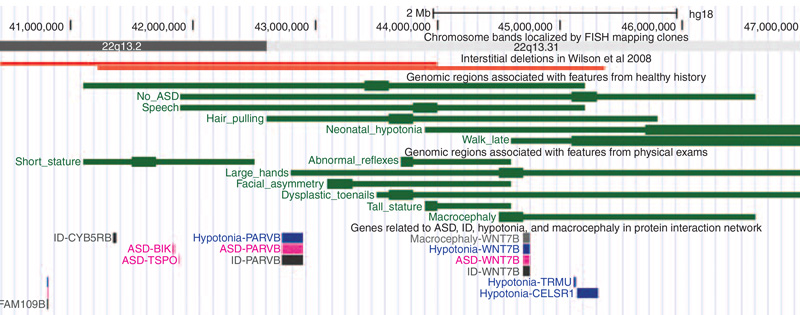
THIS ARTICLE IS MORE THAN FIVE YEARS OLD
This article is more than five years old. Autism research — and science in general — is constantly evolving, so older articles may contain information or theories that have been reevaluated since their original publication date.
Different genes located in an autism-linked section of chromosome 22 may modulate a number of symptoms, such as speech problems, large head size and low muscle tone, researchers reported 17 October in Genetics in Medicine1.
The findings suggest complex interactions among the approximately 140genes in the 22q13 region, including SHANK3, the most well-studied gene. SHANK3 is one of the strongest autism risk factors. People missing the 22q13 chromosomal region have Phelan McDermid syndrome, characterized by problems with speech, severe intellectual disability, seizures and, often, autism.
In a 2011 study, researchers looked at 70 individuals who have a 22q13 deletion ranging in size from 0.2 to 9.2 megabases. Each deletion includes SHANK3 and all but two encompass IB2, a nearby gene that has also been linked to neurodevelopmental disorders.
The study found that individuals with the largest deletions have the most severe symptoms, suggesting that other genes in the region contribute to the syndrome.
In the new study, the same team of researchers carefully mapped symptoms in these same individuals, looking to see whether the deletion of certain regions alters specific symptoms. They found, for example, that loss of a region that includes the NUP50 gene is linked to large head size and fleshy hands.
Deletion of another large region within 22q13 that includes 45 genes leads to problems with speech. This stretch includes two genes, PARVB and WNT7B, known to interact with other autism-linked genes.
The larger the deletion, the worse some symptoms become, suggesting that there is an additive effect to losing multiple genes. For example, 90 percent of people with a large deletion have low muscle tone at birth, compared with 20 percent of those with a small deletion.
Interestingly, people with the smallest deletions, which encompass mainly SHANK3, are the most likely to have an autism diagnosis. This may be because the severe intellectual disability and developmental delay that result from larger deletions hide autism symptoms, the researchers say. It is also possible that the loss of other genes obscures the specific effect of SHANK3 loss.
The results suggest that homing in on the source of symptoms within a stretch of a chromosome may be more complicated than implicating a single gene.
References:
1: Sarasua S.M. et al. Genet. Med. Epub ahead of print (2013) PubMed
By joining the discussion, you agree to our privacy policy.